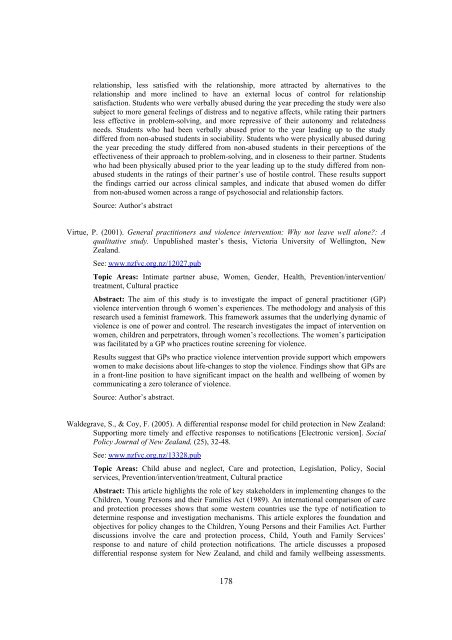annotated bibliography of new zealand research into family violence
annotated bibliography of new zealand research into family violence
annotated bibliography of new zealand research into family violence
Create successful ePaper yourself
Turn your PDF publications into a flip-book with our unique Google optimized e-Paper software.
elationship, less satisfied with the relationship, more attracted by alternatives to therelationship and more inclined to have an external locus <strong>of</strong> control for relationshipsatisfaction. Students who were verbally abused during the year preceding the study were alsosubject to more general feelings <strong>of</strong> distress and to negative affects, while rating their partnersless effective in problem-solving, and more repressive <strong>of</strong> their autonomy and relatednessneeds. Students who had been verbally abused prior to the year leading up to the studydiffered from non-abused students in sociability. Students who were physically abused duringthe year preceding the study differed from non-abused students in their perceptions <strong>of</strong> theeffectiveness <strong>of</strong> their approach to problem-solving, and in closeness to their partner. Studentswho had been physically abused prior to the year leading up to the study differed from nonabusedstudents in the ratings <strong>of</strong> their partner’s use <strong>of</strong> hostile control. These results supportthe findings carried our across clinical samples, and indicate that abused women do differfrom non-abused women across a range <strong>of</strong> psychosocial and relationship factors.Source: Author’s abstractVirtue, P. (2001). General practitioners and <strong>violence</strong> intervention: Why not leave well alone?: Aqualitative study. Unpublished master’s thesis, Victoria University <strong>of</strong> Wellington, NewZealand.See: www.nzfvc.org.nz/12027.pubTopic Areas: Intimate partner abuse, Women, Gender, Health, Prevention/intervention/treatment, Cultural practiceAbstract: The aim <strong>of</strong> this study is to investigate the impact <strong>of</strong> general practitioner (GP)<strong>violence</strong> intervention through 6 women’s experiences. The methodology and analysis <strong>of</strong> this<strong>research</strong> used a feminist framework. This framework assumes that the underlying dynamic <strong>of</strong><strong>violence</strong> is one <strong>of</strong> power and control. The <strong>research</strong> investigates the impact <strong>of</strong> intervention onwomen, children and perpetrators, through women’s recollections. The women’s participationwas facilitated by a GP who practices routine screening for <strong>violence</strong>.Results suggest that GPs who practice <strong>violence</strong> intervention provide support which empowerswomen to make decisions about life-changes to stop the <strong>violence</strong>. Findings show that GPs arein a front-line position to have significant impact on the health and wellbeing <strong>of</strong> women bycommunicating a zero tolerance <strong>of</strong> <strong>violence</strong>.Source: Author’s abstract.Waldegrave, S., & Coy, F. (2005). A differential response model for child protection in New Zealand:Supporting more timely and effective responses to notifications [Electronic version]. SocialPolicy Journal <strong>of</strong> New Zealand, (25), 32-48.See: www.nzfvc.org.nz/13328.pubTopic Areas: Child abuse and neglect, Care and protection, Legislation, Policy, Socialservices, Prevention/intervention/treatment, Cultural practiceAbstract: This article highlights the role <strong>of</strong> key stakeholders in implementing changes to theChildren, Young Persons and their Families Act (1989). An international comparison <strong>of</strong> careand protection processes shows that some western countries use the type <strong>of</strong> notification todetermine response and investigation mechanisms. This article explores the foundation andobjectives for policy changes to the Children, Young Persons and their Families Act. Furtherdiscussions involve the care and protection process, Child, Youth and Family Services’response to and nature <strong>of</strong> child protection notifications. The article discusses a proposeddifferential response system for New Zealand, and child and <strong>family</strong> wellbeing assessments.178












